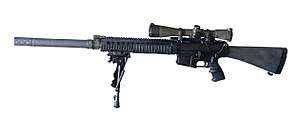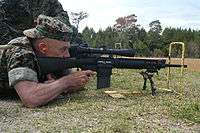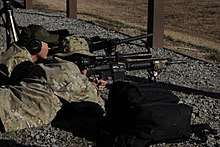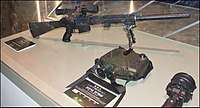Knight's Armament Company SR-25
The SR-25 (Stoner Rifle-25)[1] is a designated marksman rifle designed by Eugene Stoner and manufactured by Knight's Armament Company.[1]
| SR-25 | |
|---|---|
 An SR-25 outfitted with a riflescope, bipod and a detachable suppressor | |
| Type | Designated marksman rifle |
| Place of origin | United States |
| Service history | |
| In service | 1990–present |
| Used by | See Users |
| Production history | |
| Designer | Eugene Stoner |
| Manufacturer | Knight's Armament Company |
| Specifications | |
| Mass | Match Rifle 10.75 lb (4.88 kg), LwMatch 9.5 lb (4.3 kg), Carbine 7.5 lb (3.4 kg), Sporter 8.75 lb (3.97 kg) |
| Length | 1,118 mm (44.0 in) |
| Barrel length | Match Rifle 24 in (610 mm) |
| Cartridge | 7.62×51mm NATO |
| Action | Gas-operated, rotating bolt |
| Rate of fire | Semi-automatic |
| Feed system | 10 and 20-round detachable box magazine |
The SR-25 uses a rotating bolt and a direct impingement gas system. It is loosely based on Stoner's AR-10, rebuilt in its original 7.62×51mm NATO caliber. SR-25 barrels were originally manufactured by Remington Arms with its 5R (5 grooves, right twist) rifling, with twist 1:11.25. The heavy 20-inch (510 mm) barrel is free-floating, so handguards are attached to the front of the receiver and do not touch the barrel.
In 2005, a modified version of the SR-25 / Mk 11 rifle won US Army Semi-Automatic Sniper Rifle (XM110 SASR) competition, and today it is being issued to US Army snipers as the M110 Semi-Automatic Sniper System.
History
In the late 1950s, Eugene Stoner designed the AR-10 battle rifle. It was accurate for an auto-loading rifle, but it lost the competition to the M14 rifle. The patent rights for the AR-10 and the AR-15 were sold to Colt's Manufacturing Company. Colt focused on the AR-15, giving others the ability to capitalize on the AR-10 system.[2]
In the early 1990s, Stoner joined Knight's Armament Company and continued his AR-10 design work. The end result was the SR-25 (adding together the numbers of the AR-10 and AR-15) which improved the AR-10 design with M16A2 advancements and parts commonality. The original SR-25 was released in the early 1990s and had a heavy free-floating 24 in (610 mm) match grade barrel with a fiberglass handguard. It had a flat-top upper receiver with a Mil-Std 1913 rail for mounting optics and a 2-stage match grade trigger. The bolt carrier was similar to the AR-10's, being chrome plated and having a captive firing pin retainer pin. The SR-25 was designed specifically to fire 168 gr (10.9 g) open-tip match cartridges. Accuracy was guaranteed at or under 1 minute of angle. The SR-25 uses what has become colloquially known as SR-25 pattern magazines. At first, AR-10 type 20-round magazines were used, but they were later replaced by steel 20-round magazines.[2]
The United States Special Operations Command took interest in the SR-25, particularly its high magazine capacity and faster engagement time compared to bolt-action rifles. After some modifications, SOCOM adopted the SR-25 as the Mk 11 Mod 0 in May 2000. Changes included a shorter 20 in (510 mm) barrel that could fire M118 and M118LR 7.62×51mm NATO rounds and had a quick detachable sound suppressor mount. An 11.35 in (288 mm) free-floating handguard rail system allowed mounting accessories. Flip-up front sights and adjustable back-up iron sights were added, and an M16A2 stock and pistol grip were used.[2]
Beginning in mid-2011, SOCOM began divesting the Mk 11 Mod 0 from their inventory and replacing it with the SSR Mk 20, the sniper variant of the FN SCAR. The Mk 11 is to be completely replaced by 2017.[3]
Design

The SR-25 enhanced match rifle utilizes the newer URX II Picatinny-Weaver rail system, rather than the older Mk 11 free-floating RAS, on the top of the receiver to accept different scope mounts or a carrying handle with iron sights (front sight mounted on the rail located on the forward end of the non-modular handguard).[4] The match version is designed to shoot at a precision of 0.5 minutes of angle, which corresponds to 0.5-inch (13 mm) groups at 100 yards (91 m).
The Mk 11 Mod 0 system is chambered for 7.62×51mm NATO and is designed for match-grade ammunition. The Mk 11 system includes the rifle, 20 round box magazines, QD (Quick Detachable) scope rings, Leupold Mark 4 Mil-dot riflescope, Harris swivel-base bipod on a Knight's mount, and QD sound suppressor, which is also manufactured by Knight's Armament Co.[1] Flip-up BUIS (Back up iron sights) are attached to the modified gas block and upper receiver.
The Mk 11 Mod 0 utilizes an Obermeyer 20 in (510 mm) match target barrel, along with a RAS (Rail Accessory System) fore-end made by KAC, consisting of an 11.35 in (288 mm) long match fore-end. The RAS allows for quick attachment/detachment of MIL-STD-1913 components. The aluminum fore-end makes no contact with the barrel forward of the receiver, allowing for extreme accuracy. The Mk 11 Mod 0 has an empty weight of 15.3 lb (6.9 kg), and an overall length of 45.4 in (115 cm). The civilian version, using the longer 24 in (610 mm) match barrel, is guaranteed to produce groupings of less than 1 in (25 mm) at 100 yd (91 m), or 0.3 angular mil, using factory match loads.
During the Iraq War, the United States Marine Corps ordered 180 Mk 11 Mod 1 rifles. These were Mk 11s equipped with the upper receiver of the M110 Semi-Automatic Sniper System. The M110 upper gave the Mk 11 Mod 1 a URX modular rail system and a flash suppressor on the barrel. These saw limited use before they were phased out when the Marines chose to purchase the Mk 11 Mod 2, which was simply the USSOCOM and U.S. Navy designation for the complete M110 rifle.[5]
The new SR-25 Enhanced Match (E.M.) Carbine is very similar to the KAC M110 Semi-Automatic Sniper System,[4] though the M110 utilizes the newer URX Rail system, a length-adjustable fixed buttstock, and an integrated flash suppressor. Starting late 2011, USMC snipers will replace Mk 11 Mod 0 rifles with the M110 on a one-for-one basis.
Gallery
 Israeli Defense Forces SR-25 with a suppressor.
Israeli Defense Forces SR-25 with a suppressor. A U.S. Marine general fires the Mk 11.
A U.S. Marine general fires the Mk 11. Marksmen from the U.S. Coast Guard Maritime Security Response Team with Mk 11s
Marksmen from the U.S. Coast Guard Maritime Security Response Team with Mk 11s Navy SEALs sniper with MK 11.
Navy SEALs sniper with MK 11. IDF SR-25 Mk 11 sniper rifle, 2018
IDF SR-25 Mk 11 sniper rifle, 2018
Users
.svg.png)






See also
- United States Navy Mark 12 Mod X Special Purpose Rifle
- List of individual weapons of the U.S. Armed Forces
- Nicholas Irving
References
- Max R. Popenker. "Knights SR-25, Mk.11 Mod.0 and XM110 sniper rifle (USA)". Archived from the original on 2010-06-29. Retrieved 2010-06-27.
- Knight’s Armament M110: The New Breed of Sniper Rifle Archived 2013-11-09 at the Wayback Machine - SAdefensejournal.com, 5 January 2012
- USASOC Reveals FNH-USA Mk20 Plan Archived 2014-10-22 at the Wayback Machine - Kitup.Military.com, 8 June 2011
- "SR-25 EM SERIES". Knight's Armament Company. Archived from the original on 2012-10-22. Retrieved 2010-06-27.
- Mk 11 Mod 1/2 Archived 2012-08-08 at the Wayback Machine – Thefirearmblog.com, September 29, 2009
- "Archived copy". Archived from the original on 2009-06-22. Retrieved 2010-08-13.CS1 maint: archived copy as title (link)
- "Defence Jobs: Airfield Defence Guard - Further Training". Department of Defence. Archived from the original on 23 July 2008. Retrieved 19 April 2016.
- "Archived copy" (PDF). Archived from the original (PDF) on 2011-09-29. Retrieved 2011-09-05.CS1 maint: archived copy as title (link)
- "Archived copy". Archived from the original on 2012-09-02. Retrieved 2011-12-28.CS1 maint: archived copy as title (link)
- Hassan, Kamrul (1 February 2010). "জঙ্গি-সন্ত্রাস দমনে র্যাব-পুলিশকে অস্ত্র ও প্রশিক্ষণ দিচ্ছে যুক্তরাষ্ট্র". Prothom Alo (in Bengali). Retrieved 16 August 2019.
- "Dhaka Metropolitan Police SWAT - Overview". bdmilitary. Retrieved 22 February 2009.
- "isayeret.com". isayeret.com. Archived from the original on 2016-03-06. Retrieved 2016-06-07.
- "US Department of State Letter on July 7, 2004" (PDF). US Department of State. Archived from the original (PDF) on October 16, 2011. Retrieved 2012-02-09.
- "The Usg Is Helping Defeat the Terrorists on Jolo". Archived from the original on 2016-03-04 – via WikiLeaks PlusD.
- Wilk (REMOV), Remigiusz. "Nowe gromy GROM". Archived from the original on 2010-03-26.
- "PANTIP.COM : P9190213 ԧѹͧ + Ҿѹ Ǣͧѹҧ Ҵ١ѹ []". Archived from the original on 3 March 2016. Retrieved 15 November 2014.
- Jones, Richard D. Jane's Infantry Weapons 2009/2010. Jane's Information Group; 35th edition (January 27, 2009). ISBN 978-0-7106-2869-5.
External links
| Wikimedia Commons has media related to Knight SR-25. |